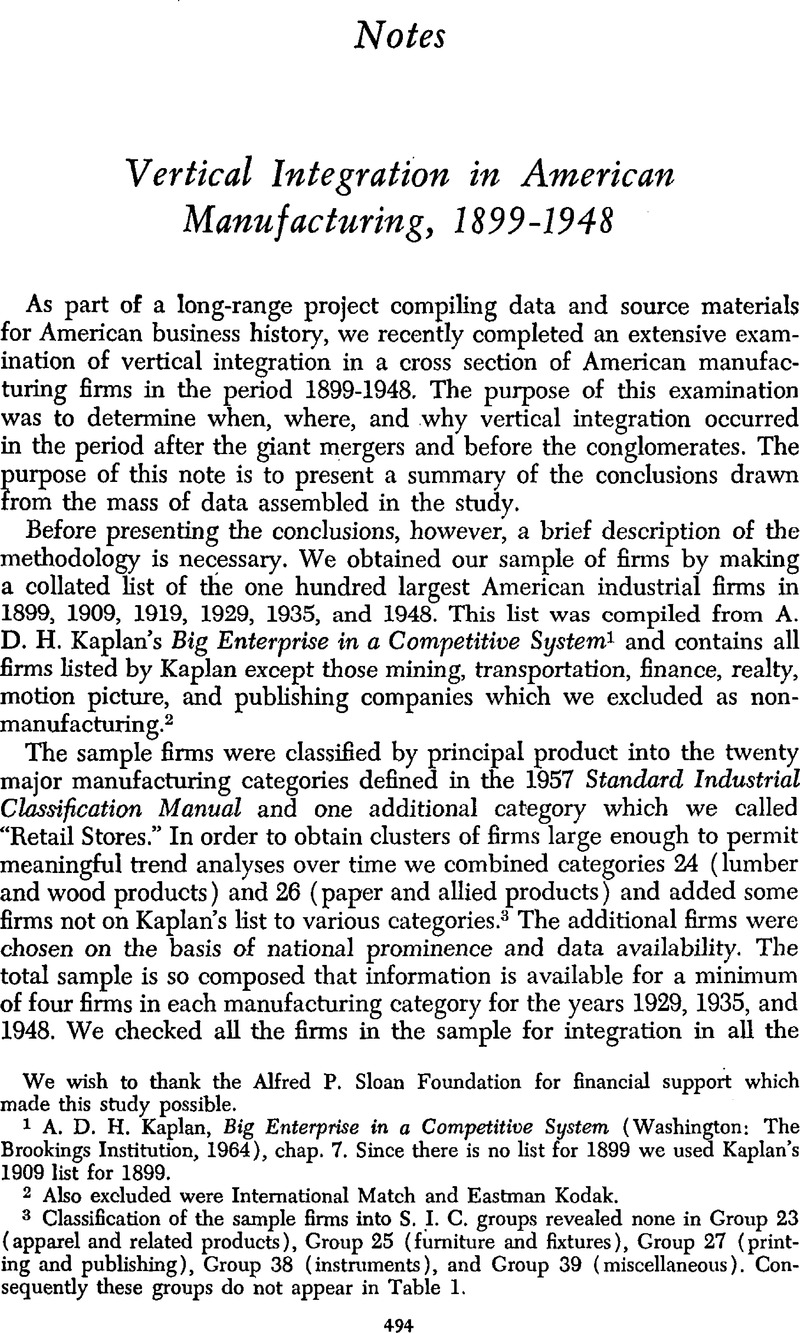Published online by Cambridge University Press: 03 February 2011

We wish to thank the Alfred P. Sloan Foundation for financial support which made this study possible.
1 Kaplan, A. D. H.Big Enterprise in a Competitive System (Washington: The Brookings Institution, 1964), chap. 7. Since there is no list for 1899 we used Kaplan's 1909 list for 1899.Google Scholar
2 Also excluded were International Match and Eastman Kodak.
3 Classification of the sample firms into S. I. C. groups revealed none in Group 23 (apparel and related products), Group 25 (furniture and fixtures), Group 27 (printing and publishing), Group 38 (instruments), and Group 39 (miscellaneous). Consequently these groups do not appear in Table 1.
4 Williamson, Harold F., Daum, Arnold R., et al., The American Petroleum Industry (2 vols.; Evanston, Ill.: Northwestern University Press, 1959–1963).Google Scholar
5 Garratynau, John A., Right Hand Man (New York: Harper & Brothers, 1957), pp. 127–28Google Scholar; Emmet, Boris and Jeuck, John E., Catalogs and Counters: A History of Sears, Roebuck (Chicago: University of Chicago Press, 1950), p. 244.Google Scholar
6 Passer, Harold C., “Electrical Manufacturing Around 1900,” Journal of Economic Hisotry, XII (Dec. 1952), 378–95; also General Electric Annual Reports in Baker Library, Harvard University.CrossRefGoogle Scholar
7 The petroleum industry had, of course, integrated into retailing before the arrival of the automobile, but the integrated retailing network which developed in the twentieth century was a result of the market for gasoline, not for illuminating oil.
8 The development of integrated marketing facilities in harvesters, typewriters, meat packing, cigarettes, and other industries is summarized in Chandler, Alfred D. Jr, “The Beginnings of ‘Big Business’ in American Industry,” Business History Review, XXXIII (Spring 1959), 1–31.CrossRefGoogle Scholar Chandler also shows the necessity for competitive imitation of integrated distribution facilities.
9 These terms are Robert T. Averitt's. The center economy includes those firms which are large, diversified, integrated, decentralized competitors in national and sometimes international markets. Firms in the center economy are rich in managerial and technical talent and financial resources. The peripheral economy is composed of relatively small firms with narrower horizons, a small line of related products, centralized management, poorer credit, and a tendency to focus on short-run problems. See Averitt, R. T., The Dual Economy (New York: W. W. Norton, 1968), pp. 1–2.Google Scholar
10 Gort, Michael, Diversification and Integration in American Industry (Princeton: Princeton University Press, 1962), pp. 6–7.Google Scholar For 1948 concentration information we used the Census Bureau's concentration ratio data in United States House of Representatives, Judiciary Committee, Subcommittee on Study of Power, Monopoly, Study of Monopoly Power, Part 2-B (Washington, D. C: U.S. Government Printing Office, 1950), pp. 1436–56Google Scholar, and Kaysen, Carl and Turner, Donald F., Antitrust Policy: An Economic and Legal Analysis (Cambridge: Harvard University Press, 1959), pp. 273–331.CrossRefGoogle Scholar For the prewar years we used our own studies of concentration in manufacturing which are based primarily on decennial Censuses of Manufactures. For diversification data we used another of our own studies.